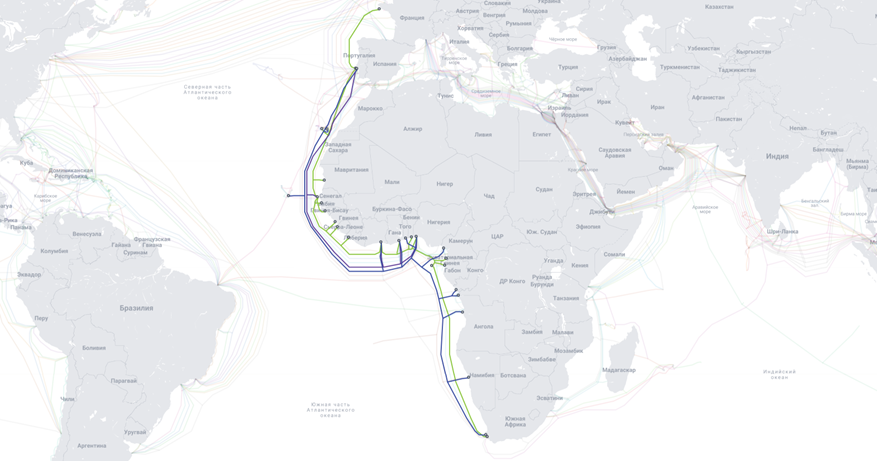A cable malfunction on the west coast deprives the continent of darkness.
On the west coast of Africa, at least 3 underwater cables were damaged, causing major disruptions to Internet services across the continent.
The damage affected key telecommunications trunks-the West Africa Cable System (WACS), MainOne and Africa Coast to Europe (ACE) cable systems, resulting in widespread outages and network problems for mobile operators and Internet service providers. The cause of cable failures has not yet been determined.
According to analytics companies NetBlocks, Kentik, and Cloudflare, the largest communication disruptions are observed in 8 countries in West Africa, among which Ivory Coast, Liberia, and Benin are the most affected. Problems also affected Ghana, Nigeria and Cameroon, and several companies reported service violations in South Africa.
The largest African mobile operators are MTN Group and Vodacom Group Ltd. Connection problems were reported in South Africa due to faulty submarine cables. MTN works to redirect traffic through alternative network paths and speed up the repair process for damaged cables. Kentik warned that long-term violations will last for several weeks.

Damaged cables
The impact of undersea cable failures is not only felt in the telecommunications industry, but also affects the cloud services and applications of major technology companies, including Microsoft, which confirmed disruptions to its Microsoft 365 cloud services and applications across Africa due to reduced throughput.
The Red Sea is a key telecommunications route connecting Europe to Africa and Asia via Egypt. Damaged cables carried about 25% of traffic in the region. Cable problems at both ends of the continent create a capacity shortage, forcing customers to seek alternative routes.
The incident follows a similar event in the Red Sea, where 4 telecommunications cables out of more than 15 submarine cables in the region (Seacom, TGN, AAE-1, EIG) were cut, resulting in a 25% reduction in capacity. It is important to note that about 15% of Asian traffic is directed to the west, and 80% of traffic passes through these cables in the Red Sea.
On the west coast of Africa, at least 3 underwater cables were damaged, causing major disruptions to Internet services across the continent.
The damage affected key telecommunications trunks-the West Africa Cable System (WACS), MainOne and Africa Coast to Europe (ACE) cable systems, resulting in widespread outages and network problems for mobile operators and Internet service providers. The cause of cable failures has not yet been determined.
According to analytics companies NetBlocks, Kentik, and Cloudflare, the largest communication disruptions are observed in 8 countries in West Africa, among which Ivory Coast, Liberia, and Benin are the most affected. Problems also affected Ghana, Nigeria and Cameroon, and several companies reported service violations in South Africa.
The largest African mobile operators are MTN Group and Vodacom Group Ltd. Connection problems were reported in South Africa due to faulty submarine cables. MTN works to redirect traffic through alternative network paths and speed up the repair process for damaged cables. Kentik warned that long-term violations will last for several weeks.

Damaged cables
The impact of undersea cable failures is not only felt in the telecommunications industry, but also affects the cloud services and applications of major technology companies, including Microsoft, which confirmed disruptions to its Microsoft 365 cloud services and applications across Africa due to reduced throughput.
The Red Sea is a key telecommunications route connecting Europe to Africa and Asia via Egypt. Damaged cables carried about 25% of traffic in the region. Cable problems at both ends of the continent create a capacity shortage, forcing customers to seek alternative routes.
The incident follows a similar event in the Red Sea, where 4 telecommunications cables out of more than 15 submarine cables in the region (Seacom, TGN, AAE-1, EIG) were cut, resulting in a 25% reduction in capacity. It is important to note that about 15% of Asian traffic is directed to the west, and 80% of traffic passes through these cables in the Red Sea.
